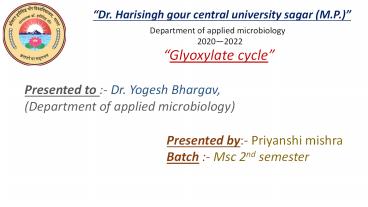Glyoxylate cycle - PowerPoint PPT Presentation
Title:
Glyoxylate cycle
Description:
Cyclic, anabolic biochemical pathway – PowerPoint PPT presentation
Number of Views:99
Title: Glyoxylate cycle
1
Dr. Harisingh gour central university sagar
(M.P.)
Department of applied microbiology
20202022
Glyoxylate cycle
Presented to - Dr. Yogesh Bhargav, (Department
of applied microbiology)
Presented by- Priyanshi mishra Batch - Msc 2nd
semester
2
SYNOPSIS
- Introduction
- Steps of glyoxylate cycle
- Glyoxylate pathway
- Relationship between Glyoxylate and TCA
- Coordinate regulation between TCA and glyoxylate
cycle - Significance of glyoxylate cycle.
3
Glyoxylate cycle
- Discovered by A. Krebs and H. L.korenberg.
- In plants, certain invertebrates, and some
microorganism ( including E.coli and yeast)
acetate can serve both as an energy rich fuel and
as a source Of PEP for carbohydrate synthesis. - In these organisms, enzymes of the glyoxylate
cycle catalyze the net conversion of acetate to
Succinate or other 4 carbon intermediate of the
citric acid cycle - 2Acetyl-CoA NAD 2H2O
Succinate 2CoA
NADH H - Definition The glyoxylate cycle, a variation
of the tricarboxylic acid cycle, is an anabolic
pathway occurring in plants, bacteria, protista
and fungi. The glyoxylate cycle centers on the
conversion of aacetyl-CoA to Succinate for the
synthesis of carbohydrates. - Utilizes five of eight enzymes associated with
the tricarboxylic acid cycle- - Citrate synthase,
- Aconitase,
- Succinate dehydrogenase,
- Fumarase,
- Malate dehydrogenase.
- It occurs in glyoxysome (a kind of peroxisome) .
- Bypass Consist of two reactions namely-
- Splitting of isocitrate into succinate and
glyoxylate, - The conversion of glyoxylate into Malate.
4
Steps of glyoxylate cycle
Step 1)
Condensation of acetyl-CoA with oxaloacetate
Acetyl-CoA produced either from acetate or by
- oxidation of fatty acids enters into TCA cycle
and is condensed with oxaloacetate to form
citrate.
ß
O O
O
Coo-
C SCoA CCoo-
CSCoA
CH2 HSCoA
H
CH3
CH2
CH2
HOCCoo-
Coo-
HOCCoo-
CH2
CH2
Coo-
Coo-
Citrate synthetase
Hydrolysis
H2O
Condensation
Coenzyme-A
Acetyl-CoA
Oxaloacetate
Citrate
Citryl-CoA (Enzyme-bound)
5
Isomerization of citrate into isocitrate
Step 2)
Citrate is isomerized to isocitrate in TCA cycle.
(Enzyme-bound)
Step 3)
Cleavage of isocitrate into succinate and
glyoxylate
This is the bypass reaction of TCA cycle. Unlike
the breakdown of isocitrate dehydrogenase in TCA
cycle, here isocitrate is cleaved by isocitrate
lease to form succinate and glyoxylate.
Coo-
Coo-
CH2
HCH CHO
HCCoo-
HCH Coo-
HCOH
Coo-
Coo-
Isocitrate lyase
Glyoxylate
Succinate
Isocitrate
6
Step 4)
Conversion of glyoxylate into malate
Succinate is further metabolized by TCA cycle.
Glyoxylate then condenses with a second molecule
of acetyl-CoA to form Malate catalyzed by Malate
synthase.
CHO SCoA
Coo-
H2O
Coo-
C0
HOCH CoASH H
CH3
HOCH
Coo-
Malate synthase
Coenzyme-A
Glyoxylate
Acetyl-CoA
L-malate
7
Step 5)
Dehydrogenation of Malate to oxaloacetate
Malate is oxidized subsequently to oxaloacetate
by the enzyme Malate dehydrogenase. Oxaloacetate
then starts another turn of the cycle.
Coo- CO
NADH H CH2
Coo-
Coo- HoCH NAD
HCH Coo-
L-malate dehydrogenase
L-malate
Oxaloacetate
8
Net reaction
- Net conversion of 2 acetyl-CoA to OAA
(or succinate) instead of 4 CO2 as in TCA. - The transport of a succinate from glyoxysome to
mitochondrion depletes 4 carbon atoms
from glyoxysome. The source of these 4 carbon
atoms are 2 acetyl-CoA.
Glyoxylate cycle
Acetyl-CoA
Succinate coenzyme-A
Glyoxylate cycle
2CH3COSCoA NAD 2H2O
CH2Coo-
2CoASH
NADH 3H
CH2Coo-
Acetyl-CoA
Coenzyme-A
Succinate
9
Glyoxylate cycle
10
Relationship between TCA and glyoxylate cycle
- In germinating seeds, the enzymatic
transformations of decarboxylic acid and
tricarboxylic acid occur in there intracellular
compartments. - Mitochondria,
- Glyoxysome,
- Cytoplasm.
- There is a continuous exchange of metabolites in
these compartments they linked with each other in
this way.
11
Coordinate regulation of TCA and glyoxylate cycle
12
Control and regulation phenomenon
13
Significance of glyoxylate pathway
- It is a bypass reaction of TCA cycle,
- Oxaloacetate formed in this pathway can be used
to synthesize glucose via gluconeogenesis, - It occurs In bacteria when they are cultured in
acetate rich carbon source (acetate being the
sole source of carbon). - This pathway is very significant in germinating
seeds where the stored triglycerols (fat) is
converted into sugar to meet the energy needs. - When higher fatty acids are oxidized into
acetyl-CoA enters into glyoxylate cycle. - Regulation of isocitrate dehydrogenase activity
determines the partitioning of isocitrate between
the glyoxylate and citric acid cycles. - When the enzyme is inactivated by phosphorylation
(by a specific protein kinase) , isocitrate into
biosynthetic reactions via glyoxylate cycle, - When the enzyme is activated by dephosphorylation
( by specific phosphatase), isocitrate enters the
TCA cycle and ATP is produced.
14
(No Transcript)





















![Figure 22-48 Schematic diagram depicting the coordinated control of glycolysis and the citric acid cycle by ATP, ADP, AMP, Pi, Ca2+, and the [NADH]/[NAD+] ratio (the vertical arrows indicate increases in this ratio). PowerPoint PPT Presentation](https://s3.amazonaws.com/images.powershow.com/3889887.th0.jpg?_=201301130811)









